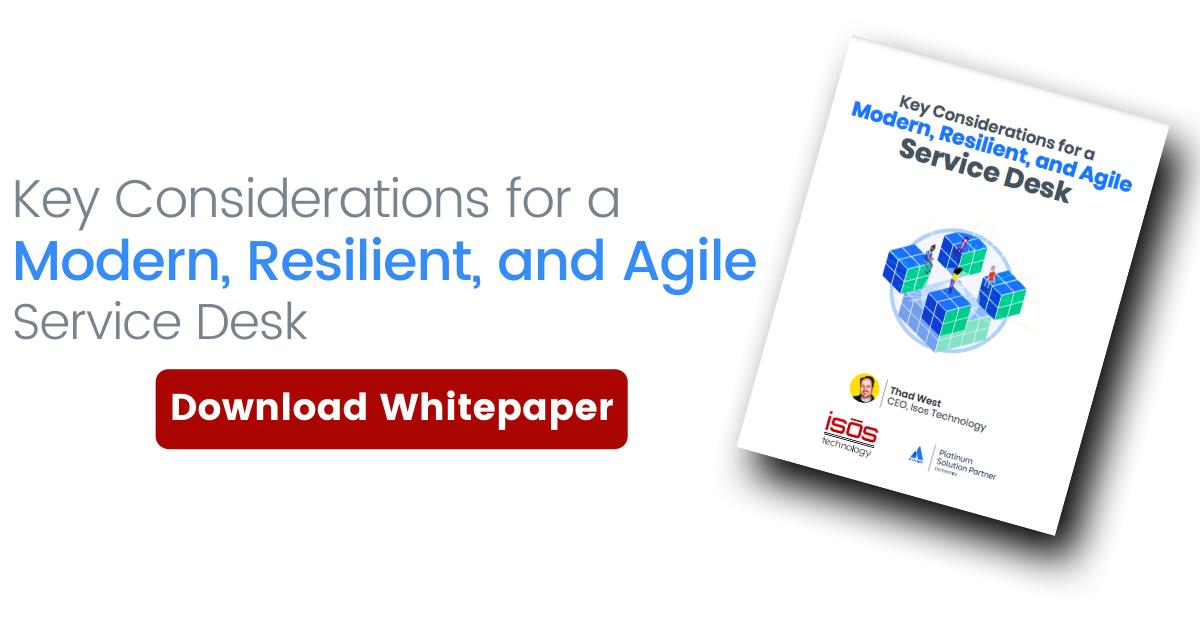At Isos Technology, one thing our clients tell us their service desk agents struggle with is how many business and software systems are in use across their organization. They have teams using Salesforce as their CRM, Smartsheet to manage projects—and the list goes on. Each of these applications are important business tools that house critical pieces of information. But when the systems don’t necessarily talk to each other, problems arise because there’s no centralized hub to share the information, view it, and act on it. It’s a hassle for the agent to resolve the issue because they don’t have access to all the information they need, and that creates a hassle for the customer who’s waiting…and waiting…for a resolution.
That’s where Jira Service Management (JSM) comes in—and has a distinct advantage over other service desk tools! There are tons of third-party apps available in the Atlassian Marketplace to streamline integrations between JSM and other critical business systems, so all your teams can work together more closely, and your service desk team can get the information they need to resolve problems faster.
Integrations Ease Service Desk Friction
In many instances, when organizations want to integrate two systems, they have to develop custom code to get the two systems talking and sharing information. It’s time-consuming, difficult, the code has to be maintained, and it can make updating the two systems really challenging. With JSM, you can often avoid this hassle and not only get your systems sharing information, but also get your teams sharing information much more easily. The Atlassian Marketplace is full of apps to connect JSM with tons of other popular, third-party business systems.
Say you want to integrate JSM with Salesforce—we’ll use this example because it’s such a common one. You can go out to the Atlassian Marketplace and find a pre-built tool to connect the systems, and as a result, information from Salesforce can automatically be pulled into your JSM ticket. Then, on the back end, the agent can see customer information, which makes life easier for both the agent and the customer. Another example: say you want to funnel information out of Smartsheets and into JSM for some special reporting—you can do that, too.
From the service desk agent’s perspective, the whole thing is frictionless. JSM serves as the information hub, and they continue to work inside of the portal. To them, it doesn’t matter what system the information is coming from—they have what they need to resolve the request.
A word of caution, though: it pays to be selective about which tools you integrate. Keep the focus on efficiency and only integrate the tools that are really needed for your service desk team to resolve common issues.
Jira Software and JSM—More Than an Integration
If your organization is already using Jira Software for project management and issue tracking, and Confluence for documentation, you may be wondering how all these tools work together. The answer is, seamlessly. This can be a distinct advantage for organizations that have a number of systems running over and around each other. There’s no need to integrate the tools—they already work together, and for teams using Jira Software, the JSM user interface is going to feel really familiar and comfortable. Plus, JSM licenses are generally less expensive and less hassle to manage, and it's much easier to onboard people so you’ll realize a faster time to value.
The Right Information at the Right Time
Once your JSM integrations are up-and-running, your agents’ lives will be a whole lot easier. When they start working on requests, they’ll have the right information at the right time, and they won't have to worry about misinformation or whether their information made it into the right system. And best of all, the process is largely automated, so it happens behind the scenes.
With JSM, all that time-consuming friction is eliminated, and your service desk agents can do more with less. They’ll be able to serve more clients, faster, and with greater efficiency and accuracy—you may even find you can do with fewer people working the desk who can be re-deployed to focus on other priorities.

Sign up to receive more great content
Learn more about Atlassian and how Isos can help by signing up to receive our latest blogs, eBooks, whitepapers and more.














